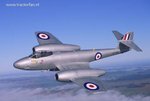It is often said, and rarely argued or even properly explained, that the Me 262 was a massive technological leap forward over all other contemporary fighters.
I wanted to quantify this and know there are many on the forum who have researched it far more deeply than me (you know who you are )
)
So the question I simply put is 'Why?'
Just to put a bit of meat on the bones of the topic I'll give voice some of my 'objections'.
Was it the swept wing?
I would say no. The 262, like the Me 163, did not employ a swept wing for transonic drag alleviation, which would be the 'advanced' reason. It was just a balance an control feature, exactly the same as the Westland Pterodactyl, or even the Monospar ST 18 we had in the ID thread recently.
Of course Germany did know about the benefits of swept wings for high speed aircraft and was working to use it long before anyone else, but this was on the Ta 183 and P.1101, not this.
Was it the engines?
They were flawed due to the materials used (out of necessity) but they were of the modern concept, being axial flow rather than centrifugal. However they were not unique as they followed the same pattern as the Metrovick Beryl which was tested on a Meteor prototype and ulitmately developed into the Sapphire and J65. I know the engines were the basis of the Russian turbojet programme but am not aware of any real influence in the west.
What about the general configuration?
Actually I think this is one of the Me262's LEAST advanced features. The general design still follows the 1930's pattern and features the pilot being accomodated on the cg, just like all the combatant piston fighters that preceded it. It was even designed to have a tailwheel until the design was modified. At a stretch, and only in this respect, you could say that Gloster were more advanced as a tricycle undercarriage and 'pilot in the nose' layout that was universdally adopted later on was not only a feature of the Meteor from the start, but also of the E28/39 as well.
So there are the roots of my question. There is certainly more to the 262 than the three questions I have posed, but they are the reasons I often see given for its 'advancement' and which therefore lead me to question it overall.
Educate me guys!
I wanted to quantify this and know there are many on the forum who have researched it far more deeply than me (you know who you are
So the question I simply put is 'Why?'
Just to put a bit of meat on the bones of the topic I'll give voice some of my 'objections'.
Was it the swept wing?
I would say no. The 262, like the Me 163, did not employ a swept wing for transonic drag alleviation, which would be the 'advanced' reason. It was just a balance an control feature, exactly the same as the Westland Pterodactyl, or even the Monospar ST 18 we had in the ID thread recently.
Of course Germany did know about the benefits of swept wings for high speed aircraft and was working to use it long before anyone else, but this was on the Ta 183 and P.1101, not this.
Was it the engines?
They were flawed due to the materials used (out of necessity) but they were of the modern concept, being axial flow rather than centrifugal. However they were not unique as they followed the same pattern as the Metrovick Beryl which was tested on a Meteor prototype and ulitmately developed into the Sapphire and J65. I know the engines were the basis of the Russian turbojet programme but am not aware of any real influence in the west.
What about the general configuration?
Actually I think this is one of the Me262's LEAST advanced features. The general design still follows the 1930's pattern and features the pilot being accomodated on the cg, just like all the combatant piston fighters that preceded it. It was even designed to have a tailwheel until the design was modified. At a stretch, and only in this respect, you could say that Gloster were more advanced as a tricycle undercarriage and 'pilot in the nose' layout that was universdally adopted later on was not only a feature of the Meteor from the start, but also of the E28/39 as well.
So there are the roots of my question. There is certainly more to the 262 than the three questions I have posed, but they are the reasons I often see given for its 'advancement' and which therefore lead me to question it overall.
Educate me guys!
Last edited:

